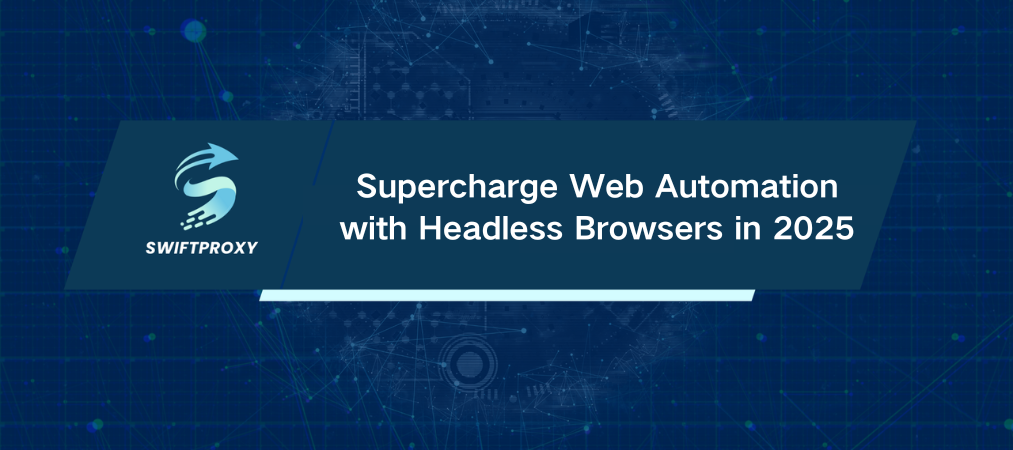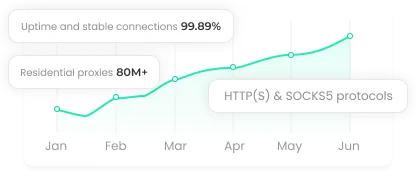Supercharge Web Automation with Headless Browsers in 2025

Automation is the backbone of modern web operations, and headless browsers are the secret sauce making it all happen. These invisible tools allow you to scrape, test, and automate tasks at lightning speed. But why should you care about headless browsing? Let's dive into the essentials and discover how these tools can supercharge your web automation.
What Exactly Is a Headless Browser
When you think "browser," you likely picture Chrome, Firefox, or Safari—clicking through tabs and interacting with the web visually. But there's another way to browse, one that's built for efficiency, speed, and precision.
A headless browser runs without a graphical user interface (GUI). Think of it as a browser that's there, but you can't see it. It's all about control and speed—perfect for tasks like web scraping, automated testing, or even running large-scale bots. And yes, it does everything a standard browser can—just without the bells and whistles. No UI. No rendering. Just raw performance.
The Importance of Headless Browsers
So, why bother with headless browsers in the first place? Let's break it down:
Speed
Headless browsers are fast. No rendering of visuals. No wasting time on animations or drawing tabs. Just pure, uninterrupted automation. Whether you're scraping data or running automated tests, this speed translates into massive efficiency. And that means less waiting around and more getting things done.
Lower Resource Usage
Picture that You're opening dozens of tabs, and suddenly, your computer starts groaning under the weight of it all. That's because each tab is actively rendering graphics, eating up CPU and RAM. A headless browser skips this overhead, using fewer system resources. This efficiency is crucial, especially for large-scale automation tasks, where even the smallest speed bump can slow down your entire process.
Seamless Automation
Imagine running automated scripts that interact with a website just like a human would—clicking buttons, filling out forms, scraping content. With a headless browser, it all happens smoothly, in the background. No distractions, no hiccups.
Use Cases for Headless Browsers
The beauty of headless browsers is in their versatility. Let's look at a few scenarios where they shine:
Automated Testing
For developers, running automated tests is a must. But let's face it—testing everything manually is time-consuming and often inefficient. Headless browsers can handle these tests quickly and reliably, simulating real user interactions without wasting any visual resources. Tools like Puppeteer, Playwright, and Selenium automate browser interactions, so you can test faster and more effectively.
Web Scraping
When you need to collect data from websites, headless browsers are your best friend. Why? Because they can interact with JavaScript-heavy pages that traditional scraping tools struggle with. These browsers load the entire page, wait for the data to appear, and then grab it—just like a human would. Whether it's product listings or market data, headless browsers make scraping efficient and accurate.
Performance Monitoring
For anyone focused on site optimization, headless browsers allow you to measure core web vitals (like Time to First Byte, Largest Contentful Paint, and First Contentful Paint) without the distractions of a graphical interface. You get precise, actionable data without compromising on performance.
Top Headless Browser Tools to Use in 2025
So, you're sold on headless browsers. But which tool should you pick? Let's break down the top contenders:
Puppeteer
For those who need deep control over Chrome or Chromium, Puppeteer is a powerhouse. This Node.js library lets you automate everything from clicking links to generating PDFs, all without launching a visible window. It's incredibly reliable for web scraping and automation tasks, and its advanced features make it a great choice for precise, customized scripts.
Why Puppeteer?
-
Full control over Chrome
-
Built-in screenshot and PDF generation
-
Advanced network control (intercept requests and responses)
-
Smooth handling of dynamic pages
Playwright
Developed by Microsoft, Playwright is a robust solution for cross-browser automation. Unlike Puppeteer, which is Chrome-specific, Playwright works across Chrome, Firefox, and Safari. This makes it an excellent option if you need to run automated tests across multiple browsers without rewriting scripts for each one.
Why Playwright?
-
Supports multiple browsers (Chrome, Firefox, WebKit)
-
Native parallelism (run scripts in parallel for faster execution)
-
Automatic waiting for elements to load
-
Built-in test runner
Selenium
Selenium has been around for a long time and is still a reliable choice, especially for teams with diverse programming language needs. Though it's not as lightweight as Puppeteer or Playwright, it's a solid, battle-tested tool for complex, cross-browser testing.
Why Selenium?
-
Extensive cross-browser support
-
Multi-language compatibility (Java, Python, C#, etc.)
-
WebDriver protocol for remote control
-
Grid support for parallel testing
Configuring Headless Browsing for Web Automation
Ready to get started? Here's a quick guide to setting up your headless browser of choice.
Puppeteer Setup
Install Puppeteer: Run npm install puppeteer in your terminal.
Create Your Script: Write a simple script to open Chrome in headless mode and interact with a page. Start with visiting Wikipedia and logging the page title.
Puppeteer's simplicity makes it perfect for getting up and running quickly, especially if you're working with Chrome.
Playwright Setup
Install Playwright: Run npm install -D @playwright/test.
Install Browsers: Use npx playwright install to install Chromium, Firefox, and WebKit.
Create Your Script: Like Puppeteer, write a simple script to open a page and print the title.
Playwright is perfect if you need flexibility across browsers, and its multi-browser support will save you time and effort.
Selenium Setup
Install Selenium: Run npm install selenium-webdriver.
Download ChromeDriver: You'll need to download a compatible ChromeDriver from the official website and point your script to it.
Selenium is ideal for those working in mixed environments or dealing with complex web interactions. While it's a bit more setup-heavy, its flexibility is unmatched.
Conclusion
And there you have it—headless browsers in a nutshell. Whether you're testing, scraping, or automating, these tools help you achieve efficiency and speed. The key takeaway? Headless browsers aren't just about running silently in the background—they're about getting things done faster and more reliably.
Now, it's your turn. Pick your tool, set it up, and start automating like a pro. Here's to smoother, faster workflows and zero visual distractions. You've got this.

















































